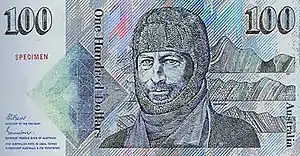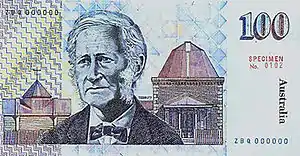Australian one-hundred-dollar note
The Australian one-hundred-dollar note was first issued in 1984 as a paper note.[2] There have been two different issues of this denomination: initially a very light turquoise-blue paper note, and from May 1996, a green polymer note.[3] Since the start of issue there have been six signature combinations. Two other combinations were not issued.
| (Australia) | |
|---|---|
| Value | 100 Australian dollars |
| Width | 158 mm |
| Height | 65 mm |
| Security features | Clear window with embossing, micro printing, slightly raised printing, hold the note towards light and the Australian coat of arms plus a seven pointed star will appear, ultraviolet, Unic serial number and different fonts, watermark |
| Material used | Polymer |
| Years of printing | 1996, 1998–99, 2008, 2010–11, 2013–14, 2017, 2019-20 [1] |
| Obverse | |
 | |
| Design | Dame Nellie Melba |
| Designer | emerystudios |
| Design date | 29 October 2020 |
| Reverse | |
 | |
| Design | Sir John Monash |
| Designer | emerystudios |
| Design date | 29 October 2020 |
In December 2016 it was reported that Australia may abolish its $100 note to close down loopholes used by the black economy.[4] However, the Reserve Bank of Australia officially stated that there are no plans to abolish the $100 note.[5]
Design
The paper issue has a portrait of Antarctic explorer Sir Douglas Mawson, with a background of a mountain range with a geological strata format. A large diamond shape appears to the left of the main picture. Astronomer John Tebbutt is on the reverse, with a background of the observatory he built and a local church.[6]
The polymer issue was designed by Bruce Stewart, and features portraits of soprano Dame Nellie Melba and engineer and First World War general Sir John Monash.[3]
A new design of the banknote, part of the Reserve Bank's Next Generation Banknote Program, is scheduled to be released into circulation in the second half of 2020.[7]
Security features
The paper design includes a watermark of Captain James Cook in the white field, and a metallic strip embedded in the paper to the left (on the obverse side) of the note. The same watermark was used in the last issue of the pre-decimal banknotes.
The polymer issue includes a shadow image of the Australian Coat of Arms, which is printed over. In the clear window, there is embossing—or a raised image—of the number 100 and a print of a lyrebird. Also for this issue, fluorescent colouring was added to the serial numbers, as well as a patch that shows the banknote's value under ultraviolet light. The star's four points on the obverse and three on the reverse join to form the seven-pointed Federation Star when the note is held up to the light. Raised print and micro-printing of the denomination value are also included.[8][9]
Circulation
According to Reserve Bank of Australia statistics, the number of $100 banknotes in circulation in June 2005 was 149 million—18.5% of all notes in circulation. The cash value for these notes was $14,924 million—41.9% of the total value for all denominations. Only the $50 note had more cash value in circulation.[10] In June 2008 there were 176.9 million notes in circulation (19%), with a value of $17,690 million (42.1%).
In June 2017, 337 million $100 notes were in circulation,[4] 22% of the total notes in circulation; worth $33,689 million, 46% of the total value for all denominations.[11]
References
- "SERIAL NUMBER INFORMATION". banknotes.rba.gov.au. Reserve Bank of Australia (RBA). Retrieved 9 February 2015.
- "OTHER BANKNOTES-PAPER SERIES-$100". banknotes.rba.gov.au. Reserve Bank of Australia. Retrieved 9 February 2015.
- "A Complete Series of Polymer Banknotes: 1992–1996". Reserve Bank of Australia Museum. Reserve Bank of Australia. Archived from the original on 15 February 2016. Retrieved 31 December 2015.
- Frank Chung. "Australia could scrap the $100 note". The New Zealand Herald. Retrieved 14 December 2016.
- https://www.sbs.com.au/yourlanguage/punjabi/en/article/2017/01/06/no-plans-withdraw-100-note-circulation
- "Inflation and the Note Issue". Reserve Bank of Australia Museum. Reserve Bank of Australia. Archived from the original on 27 April 2016. Retrieved 31 December 2015.
- "Next Generation of Banknotes: $100 Design Reveal" (Press release). Sydney, Australia: Reserve Bank of Australia. 24 February 2020. Retrieved 25 February 2020.
- "List of Security Features". Counterfeit Detection. Reserve Bank of Australia. Retrieved 9 February 2015.
- http://banknotes.rba.gov.au/banknote-features
- Notes on Issue, www.rba.gov.au, Data updated to end June 2008, Reserve Bank of Australia. Retrieved on 4 August 2015.
- "DISTRIBUTION-CIRCULATION AND PRODUCTION STATISTICS, AS AT END JUNE 2017". banknotes.rba.gov.au. Reserve Bank of Australia. Retrieved 20 December 2017.
Further reading
- Ian W. Pitt, ed. (2000). Renniks Australian Coin and Banknote Values (19th ed.). Chippendale, NSW: Renniks Publications. pp. 171–172. ISBN 0-9585574-4-6.

